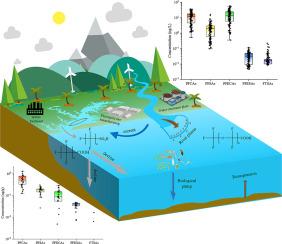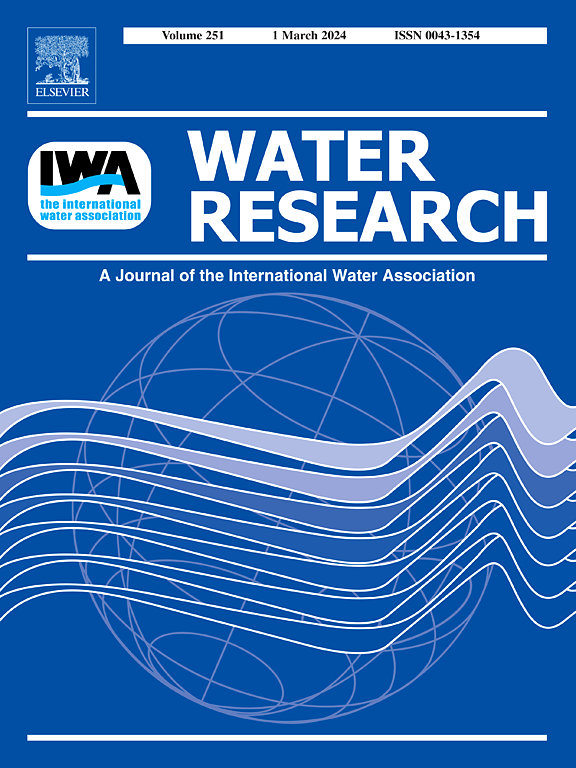Regulation of terrestrial input and ocean processes on the occurrence and transport of traditional and emerging per- and polyfluoroalkyl substances in the inner shelf of the East China Sea
IF 11.4
1区 环境科学与生态学
Q1 ENGINEERING, ENVIRONMENTAL
引用次数: 0
Abstract
Coastal oceans, serving as transitional zones between land and sea, possess unique geographical features and complex hydrological conditions, functioning as regional reservoirs and crucial transport pathways for anthropogenic pollutants such as per- and polyfluoroalkyl substances (PFASs) to the open ocean. This study comprehensively investigates traditional perfluoroalkyl carboxylic and sulphonic acids (PFCAs and PFSAs) and emerging perfluoroalkyl ether carboxylic and sulfonic acids (PFECAs and PFESAs), fluorotelomer sulfonates (FTSAs) in seawater columns and surface sediments from the inner shelf of the East China Sea, by integrating hydrological and biogeochemical data. Comparable levels of traditional and emerging PFASs were observed in seawater samples, in contrast to higher concentrations of traditional PFASs in surface sediments. Waterborne PFASs exhibited a nearshore-to-offshore decreasing trend and a surface enrichment pattern in offshore waters, typically influenced by terrestrial inputs and oceanic processes. Significant terrestrial inputs for waterborne PFASs were identified, including large rivers like the Changjiang River (Yangtze) and semi-enclosed coastal bays such as Xiangshan Port and Sanmen Bay, where prolonged hydraulic retention times contribute to PFAS accumulation. The source apportionment model demonstrated that emerging fluorochemical manufacturing, textile production, and high-performance fluoropolymer materials are primary sources, consistent with PFAS releases from commercial products and industrial processes along the Changjiang River and in Xiangshan County. Hydrologically, the offshore transport barrier effect created by river plume fronts, and the vertical stratification of different water masses were significant for PFASs. Sediment inputs and resuspension also played a crucial role, with surface sediment-bottom water partitioning behavior primarily regulated by the hydrophobicity of PFASs and salting-out effects. While the overall ecological risks of PFASs were low, elevated risks associated with legacy perfluorooctanoate (PFOA), perfluorooctane sulfonate (PFOS), and emerging hexafluoropropylene oxide dimer acid (HFPO-DA) warrant closer attention due to their accumulation in the environment. The methodologies and findings of this research provide valuable insights into PFAS cycling in coastal oceans worldwide.

陆地输入和海洋过程对东海内陆架传统和新出现的全氟烷基和多氟烷基物质的发生和迁移的调控作用
作为陆地和海洋之间的过渡地带,近海具有独特的地理特征和复杂的水文条件,是人为污染物(如全氟烷基和多氟烷基物质 (PFAS))向公海迁移的区域水库和重要途径。本研究通过整合水文和生物地球化学数据,全面调查了东海内大陆架海水水柱和表层沉积物中的传统全氟烷基羧酸和磺酸(PFCAs 和 PFSAs)、新兴全氟烷基醚羧酸和磺酸(PFECAs 和 PFESAs)、氟橡胶磺酸盐(FTSAs)。在海水样本中观察到的传统和新兴全氟辛烷磺酸含量相当,而在表层沉积物中传统全氟辛烷磺酸的浓度较高。水载全氟辛烷磺酸呈现出从近岸到近岸的递减趋势,而在近岸水域则呈现出表面富集模式,这通常受到陆地输入和海洋过程的影响。研究发现,水载全氟辛烷磺酸的重要陆源输入地包括长江等大江大河以及象山港和三门湾等半封闭沿海海湾,在这些海湾中,较长的水力滞留时间有助于全氟辛烷磺酸的积累。污染源分配模型表明,新兴的氟化工生产、纺织品生产和高性能含氟聚合物材料是主要污染源,这与长江沿岸和象山县商业产品和工业生产过程中释放的 PFAS 相一致。在水文方面,河流羽流锋面产生的离岸迁移屏障效应以及不同水体的垂直分层对 PFASs 有显著影响。沉积物的输入和再悬浮也发挥了重要作用,表层沉积物-底层水的分区行为主要受 PFAS 的疏水性和盐析效应的调节。虽然全氟辛烷磺酸(PFOA)、全氟辛烷磺酸(PFOS)和新出现的六氟环氧丙烷二聚酸(HFPO-DA)的总体生态风险较低,但由于其在环境中的累积,与遗留的全氟辛酸(PFOA)、全氟辛烷磺酸(PFOS)和新出现的六氟环氧丙烷二聚酸(HFPO-DA)相关的风险升高值得密切关注。这项研究的方法和发现为了解全球沿海海洋中全氟辛烷磺酸的循环提供了宝贵的信息。
本文章由计算机程序翻译,如有差异,请以英文原文为准。
求助全文
约1分钟内获得全文
求助全文
来源期刊

Water Research
环境科学-工程:环境
CiteScore
20.80
自引率
9.40%
发文量
1307
审稿时长
38 days
期刊介绍:
Water Research, along with its open access companion journal Water Research X, serves as a platform for publishing original research papers covering various aspects of the science and technology related to the anthropogenic water cycle, water quality, and its management worldwide. The audience targeted by the journal comprises biologists, chemical engineers, chemists, civil engineers, environmental engineers, limnologists, and microbiologists. The scope of the journal include:
•Treatment processes for water and wastewaters (municipal, agricultural, industrial, and on-site treatment), including resource recovery and residuals management;
•Urban hydrology including sewer systems, stormwater management, and green infrastructure;
•Drinking water treatment and distribution;
•Potable and non-potable water reuse;
•Sanitation, public health, and risk assessment;
•Anaerobic digestion, solid and hazardous waste management, including source characterization and the effects and control of leachates and gaseous emissions;
•Contaminants (chemical, microbial, anthropogenic particles such as nanoparticles or microplastics) and related water quality sensing, monitoring, fate, and assessment;
•Anthropogenic impacts on inland, tidal, coastal and urban waters, focusing on surface and ground waters, and point and non-point sources of pollution;
•Environmental restoration, linked to surface water, groundwater and groundwater remediation;
•Analysis of the interfaces between sediments and water, and between water and atmosphere, focusing specifically on anthropogenic impacts;
•Mathematical modelling, systems analysis, machine learning, and beneficial use of big data related to the anthropogenic water cycle;
•Socio-economic, policy, and regulations studies.
 求助内容:
求助内容: 应助结果提醒方式:
应助结果提醒方式:


